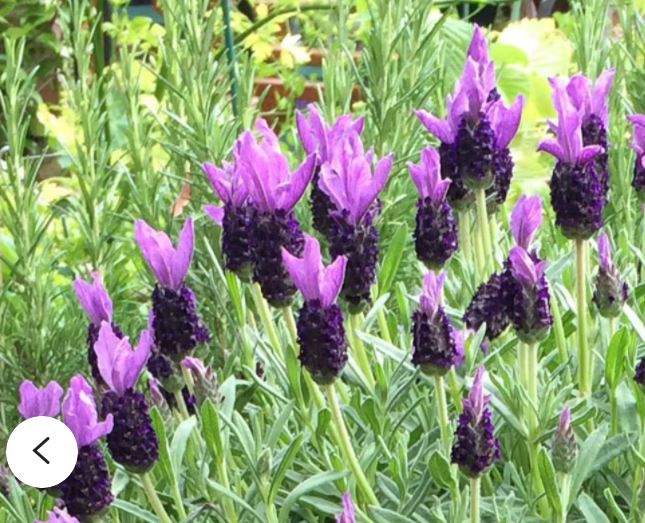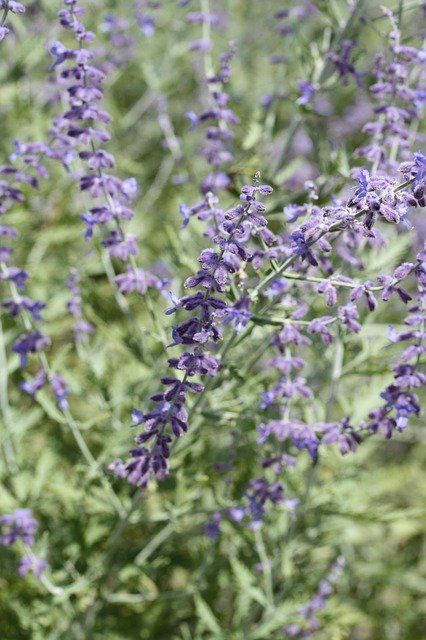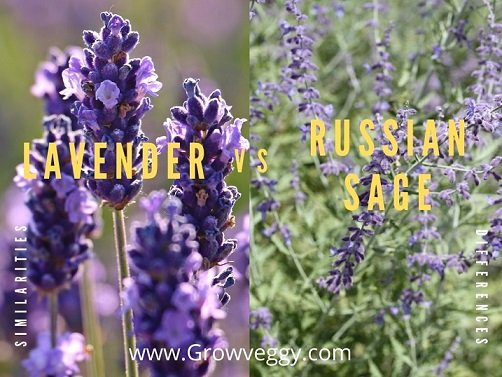Look from afar and these two plants may seem similar or even the same! But step a bit closer and you will notice the differences between the Russian sage and lavender.
| Characteristic | Russian Sage | Lavender |
|---|---|---|
| Flowers | Tubular flowers are borne in panicle arrangement | Irregularly shaped flowers are borne on the stem. No lateral stems (panicle arrangement absent) |
| Flower Colors | Blue with a slight purple hue | Blue, purple, violet, pink, white, and yellow |
| Foliage | Green leaves measuring 2 inches by 1 inch (l x w) | Greenish-grey or silver foliage measuring under an inch |
| Fragrance and Uses | Mildly fragrant used in potpourri (not useful in cooking) | Very fragrant and useful in cooking, perfumes, and medicine |
| Plant size and Shape | Height-up to 5 feet (1.5m) Width-up to 4 feet (1.2m) | Height-2.5 feet (0.8m) Width-2 feet (0.6m) |
| Soil pH | Tolerates acidic soils (pH 6.5-6.8), neutral and alkaline pH | Strictly require alkaline to neutral pH (6.5 to 8) English lavender mildly tolerates an acidic pH |
| Hardiness | USDA zones 5-9 | USDA zones 5-8 (up to zone 7 for French lavender) |
| Soil Requirement | Well-draining | Well-draining |
Differences Between Russian Sage and Lavender
Flowers size and arrangement
From a distance, you can’t really notice the differences in the flowers of these two plants.
On a closer look, you will see Inflorescences arise from the main stem in Russian sage. Its flower petioles branch off from this stem.
Each flower stalk measures around 4 inches (10 cm). Each petiole bears several small flowers (each flower measures a maximum of 1 inch). The result is a flower-full panicle measuring 13 inches long!
Lavender flowers are much different!
Lavender flowers are also borne on stems through which they are attached to the plant, except there are no lateral flower stalks. Because of this, the flowers grow very close to each other.
Lavender flowers are generally smaller than those of Russian sage with a diameter of half an inch.
In fact, a typical lavender inflorescence resembles the grain spikelet of a cereal crop like Rye except flowers appear where grains would.
Russian sage flowers are tubular while lavender flowers bear no such shape.
So, this only makes it easier to look at the flowers to try to distinguish the two and choose a winner.
One can argue that the flowers of lavender are much more appealing because they appear very closely packed to each other. The loose flower arrangement in Russian sage flowers dissipates most of the appeal.
But, the flower blooms of both plants are equally beautiful and a great addition to your garden.
Also note, Russian sage does not bloom as long as lavender but if timed correctly, these two plants can color the garden from July to October.
Flower Color
Apart from flower size and arrangement, the color of the flowers differs.
Flowers of Russian sage are predominantly blue with a slight purple hue, the shades of blue vary for each variety.
Lavender flowers come in an array of colors, some being breathtaking! While we recognize the light bluish-purple color (lavender) as the most common color, there are so many more.
Thanks to technology, the practice of cross-breeding has yielded several different lavender varieties (hybrids).
The colors of hybrid lavender plant flowers range from blue, purple, violet to even pink, white, and bright yellow!
Obviously, if you want to grow plants that develop colorful flowers, lavender surges ahead of its opponent. Russian sage only features two particular colors and does not come with many surprises.
Need to plant a lavender? Here’s our lavender comparison: English lavender vs French lavender.
Foliage
The foliage of most plants doesn’t really have any special appearance or characteristics. But this is not the case with lavender and Russian sage, two of the prettiest herbs.
A typical Russian sage plant’s leaf is up to 2 inches long (5 cm) and 1 inch in width (2.5 cm).
Leaves bear an interesting pattern as they are dissected. However, they are adjoined to main stems by small petioles. The leaves sometimes look grayish-green but are mostly green.
Lavender foliage properties vary slightly from one variety to another. Their leaves are elongated which looks most odd!
French lavender has another interesting feature, the edges of their leaves are serrated making for an appealing sight.
French lavender leaves are green while the English lavender leaves are gray.
Fragrance
Another important characteristic of the leaves of herbs is their fragrance when crushed and their oil content.
Lavender leaves are more lush than Russian sage and therefore they emit more fragrance when crushed.
Russian sage leaves are also aromatic but just not as potent as lavender leaves.
Because of the strong scent and high oil production, lavender is economically important. Its oils are vital for perfume production and in medicine.
Lavender leaves are edible but the Russian sage leaves are not!
Evidently, lavender plants are more useful and fragrant than Russian sage leaves.
Plant Size and Shape
Most lavenders are smaller (more compact) than Russian Sage. Lavenders are usually always wider than they are tall.
Lavender plants usually do not get very tall although a mature lavender can very well reach the 3 feet mark.
English lavender is a very compact plant. They rarely breach and surpass the 2.5 feet height and are never higher than 2 feet in width.
Russian sage plants easily pass 5 feet in height and 4 feet in width. This makes these plants quite large and definitely much larger than their compatriots, lavender.
Russian Sage is twice as tall as lavender and also wider.
The shape each plant takes will also be unique.
Lavender can easily be pruned into a mound shape to look neat and improve tolerance to cold.
Naturally, Russian sage will have a wide-conical shape while a mature lavender unpruned will develop into a flattened sphere shape.
Flowering lavenders are more compact since the flowers huddle together. This is not the case with Russian sage since flowers are dispersed and placed in a panicle arrangement.
Also, you will notice the sage flower inflorescences are much taller than those of the lavender.
Soil pH Requirements
Lavender has a strict requirement for alkaline (pH 6.5 to 8) or neutral soil.
Although English lavender can tolerate mildly acidic soil, all other lavenders will most likely die in such soils. Even if a lavender can survive in acidic soil, flower output will be poor.
Russian sage also grows in neutral or alkaline soil but can survive and thrive very well in acidic (pH 6.5 to 6.8) soils quite fine.
So, when soil becomes slightly acidic after being alkaline, you will not notice an extreme change in your sage plants. They will certainly not die!
Just because your soil is acidic does not mean you must grow Russian sage. If you want to grow lavender you need to increase the pH levels of the soil.
And luckily it is possible to do this by adding garden lime which is affordably available everywhere.
You can even grow both plants as long as you provide the right soils. Otherwise, the rest of the conditions in your garden will decide which plant is most suitable.
A common similarity between these plants is that both require well-draining soil which doesn’t allow water to form puddles.
Frost Hardiness
Your lavender and Russian sage will not tolerate the same levels of cold. Actually, the closest lavender that comes to matching the hardiness of Russian sage is English lavender. Otherwise, the other lavenders show a distinct difference.
Russian sage is quite hardy and will grow well in USDA zones 5 to 9. Unlike lavender, you won’t have to make efforts to shelter your plants or bring them indoors.
Unfortunately, if you live in a cold area, lavender is not for you.
French lavender cannot survive or grow in areas of USDA zone 7 and above.
English lavenders are the hardiest lavender and can tolerate USDA zones 5 to 8. This includes cold and frost conditions but it would need shelter from winds and rainfall.
Similarity Between Russian Sage and Lavender
As different as their comparisons make them sound, Lavender & Russian sage are both herbs. Therefore, this already puts many of their needs in a place of intersection.

Classification
In the plant world, classification helps to identify a plant species and pinpoint its ancestry.
So, you must be thinking ‘how does this help a gardener’? Well, knowing this information can help you to understand the plant’s origin and other requirements needed to grow the plant.
If you fail to recreate its typical growing conditions, the plant will not grow at all. It will likely die. Every plant has its own particular needs.
However, with lavender and Russian sage, there are some overlapping conditions. Hence, this must be something to do with their relationship!
Both Russian sage and lavender belong to the exact same order and family.
- Order- Lamiales
- Family- Lamiaceae
After this, each plant has its own respective genus, Salvia for sage and Lavandula for lavender. They may not be the exact same plant but they are not exactly strangers to each other!
This makes it easier to choose to plant just one of them.
Well-Draining Soil

Russian sage and lavender share a soil quality in common, both these plants dislike being planted in poorly draining soil.
Sitting in wet soil will compromise the plant. Wet soil will affect the roots first by making them soft. Eventually, the plant’s roots will rot and the plant will die.
To successfully grow lavender and Russian sage, you need well-draining soils. The most porous soils usually have a high sand or gravel content and a low clay and compost content.
Failure to produce these requirements for either of these plants can lead to ill effects. Yellowing and wilting could be signs of overwatering and should be investigated immediately.
But, if your watering routine is correct then it could be a sign that the soil is not right.
Want to avoid overwatering your lavender? Follow our guide on how often to water lavender.
Sunlight Exposure
Being herbs, both these plants will thoroughly enjoy several hours of sunlight.
In fact, this requirement comes hand-in-hand with their need for well-draining soil. Excess water is not what these plants tend to thrive in and sun rays can help de-escalate any water issues.
Sunlight helps in the development of food for the plants and also works to evaporate any excess moisture in the air. High humidity can cause lavender or sage plants to become discolored or even infected by fungus infections.
Conclusion
To the eye, one can easily mistake Russian sage for lavender and vice versa. But, there’s more than what meets the eye!
Russian sage differs from lavender in terms of size, flower color & appearance, fragrance & use, soil pH, and hardiness tolerance.
Similarities they share are sunlight requirement, family classification, and well-draining soils.
So which one is better? Well, this depends on your requirements.
- Want a useful fragrant herb or something to help in the kitchen? Lavender is ideal
- If you want a plant that grows in acidic soil with little maintenance efforts and high hardiness, Russian sage is better
- But, if you want to make your garden appealing, both lavender and Russian sage will accomplish your garden goals!
Want to grow lavender and Russian sage together? Find out if sage is a good lavender companion plant.
FAQs
Can you eat Russian sage?
Russian sage cannot be applied to cooking because of its slight toxicity. Only its flowers (which taste peppery) can be eaten and used as a garnish for tea.
The leaves are fragrant and can be effective for making potpourri and other fragrant items.
Is Russian sage poisonous to dogs?
No, Russian sage (Perovskia atriplicifolia) is not toxic to dogs in small amounts. But just to be safe, do not allow your dog to consume large amounts of this plant’s leaves.
Certain compounds could be a problem when in high concentration, one example is Thujone. In very high amounts this compound could cause liver failure.


